Südasien
Südasien ist ein Teil des asiatischen Kontinents und wird im Nordwesten, Norden und Nordosten durch Gebirge vom übrigen Asien abgetrennt. Der Raum wird bis heute, obwohl der Begriff teilweise als veraltet und kolonial-historisch besetzt gilt, auch als Vorderindien bezeichnet, es bestehen weitreichende Überlappungen zwischen den Begriffen Mittlerer Osten und Südasien.
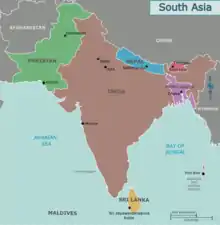
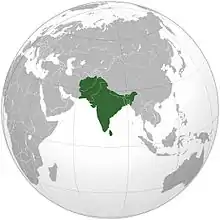
In Südasien leben 25 Prozent der Weltbevölkerung, allein in Indien leben über 1,3 Milliarden Menschen (2017).
Abgrenzung
Geologisch wird ein großer Teil Südasiens, da es eine eigene tektonische Platte darstellt, auch als indischer Subkontinent bezeichnet. Umgrenzt wird der Raum:
- vom Himalaya im Norden gegen Tibet (Ostasien) und dem Pamir gegen Zentralasien,
- dem Bergland von Belutschistan im Westen gegen Vorderasien,
- vom Patkai und Arakan-Joma-Gebirge im Osten gegen Südostasien.
- Nach Süden ist er vom Indischen Ozean umschlossen, mit dem Arabischen Meer westlich und dem Golf von Bengalen östlich der Halbinsel Indien.
Liste der Staaten
Alle Staaten in Südasien, unter anderem basierend auf der Südasiatischen Vereinigung für regionale Kooperation, sind: [1][2][3][4][5][6][7]
.svg.png.webp) Afghanistan (hauptsächlich jedoch zu Zentralasien gezählt[8])
Afghanistan (hauptsächlich jedoch zu Zentralasien gezählt[8])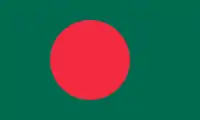 Bangladesch
Bangladesch Bhutan
Bhutan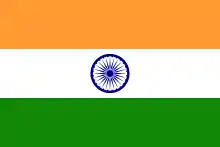 Indien
Indien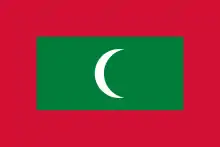 Malediven
Malediven.svg.png.webp) Nepal
Nepal Pakistan
Pakistan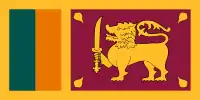 Sri Lanka
Sri Lanka
Afghanistan kommt in vielen Definitionen Südasiens nicht vor, da das Land sich an der Schnittstelle von Süd- und Zentralasien befindet und historisch, kulturell als auch linguistisch eher eine Affinität mit dem in Vorderasien liegenden Iran und den zentralasiatischen Staaten Tadschikistan, Turkmenistan und Usbekistan aufweist.[9]
 Iran wird durch die UNSD, eine Abteilung der Vereinten Nationen, ebenfalls zu Südasien gezählt,[10] in der Regel zählt Iran jedoch weltweit zu Westasien.[11]
Iran wird durch die UNSD, eine Abteilung der Vereinten Nationen, ebenfalls zu Südasien gezählt,[10] in der Regel zählt Iran jedoch weltweit zu Westasien.[11]
Literatur
- David Arnold: Südasien. (= Neue Fischer Weltgeschichte. Band 11). S. Fischer, Frankfurt am Main 2012.
Weblinks
Einzelnachweise
- Arthur Berriedale Keith: A Constitutional History of India: 1600–1935. Methuen & Co, 1936, S. 440–444.
- N. D. Arora: Political Science for Civil Services Main Examination. Tata McGraw-Hill Education, 2010, ISBN 978-0-07-009094-1, S. 42:1.
- Indian subcontinent. In: New Oxford Dictionary of English. Oxford University Press, New York 2001, ISBN 0-19-860441-6, S. 929: "the part of Asia south of the Himalayas which forms a peninsula extending into the Indian Ocean, between the Arabian Sea and the Bay of Bengal
- John McLeod: The history of India. Greenwood Publishing Group, 2002, ISBN 0-313-31459-4, S. 1.
- Stephen Adolphe Wurm, Peter Mühlhäusler, Darrell T. Tryon: Atlas of languages of intercultural communication in the Pacific, Asia, and the Americas. International Council for Philosophy and Humanistic Studies. Walter de Gruyter, 1996, ISBN 3-11-013417-9, S. 787.
- The Columbia Electronic Encyclopedia. 6. Auflage. Columbia University Press, 2003: "region, S central Asia, comprising the countries of Pakistan, India, and Bangladesh and the Himalayan states of Nepal, and Bhutan. Sri Lanka, an island off the southeastern tip of the Indian peninsula, is often considered a part of the subcontinent."
- Peter Haggett: Encyclopedia of World Geography (Vol. 1). Marshall Cavendish, 2001, ISBN 0-7614-7289-4, S. 2710.
- Svante E. Cornell: Modernization and Regional Cooperation in Central Asia: A New Spring?. Central Asia-Caucasus Institute and the Silk Road Studies, .
- The Ethnic Groups Of Afghanistan. Abgerufen am 27. April 2020.
- millenniumindicators.un.org
- Standard Country or Area Codes for Statistical Use. Millenniumindicators.un.org, abgerufen am 25. August 2012. Quote: "The assignment of countries or areas to specific groupings is for statistical convenience and does not imply any assumption regarding political or other affiliation of countries or territories by the United Nations."
